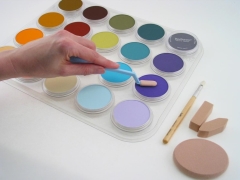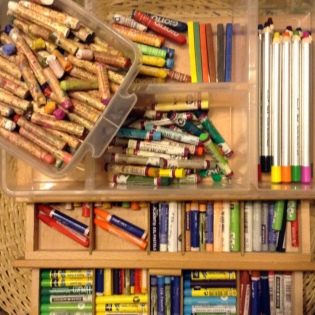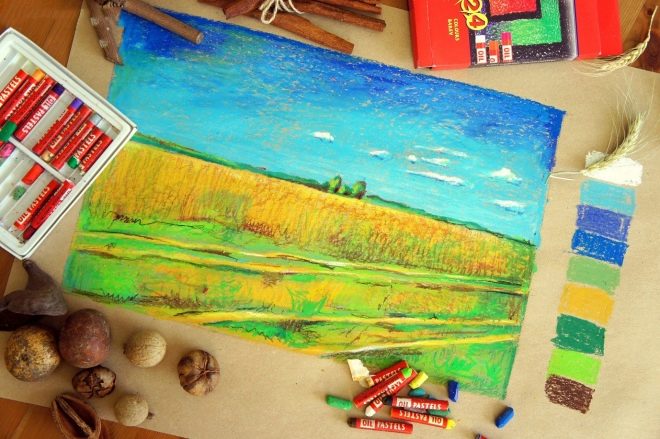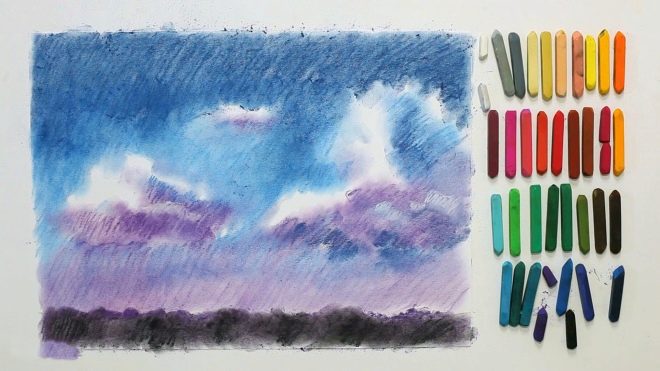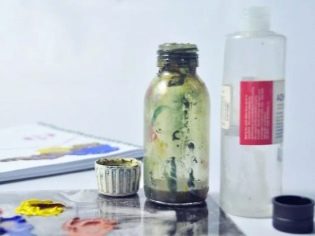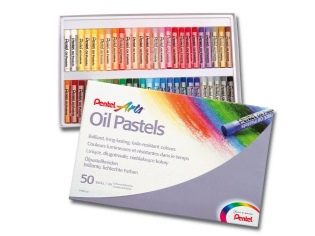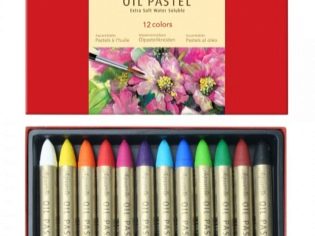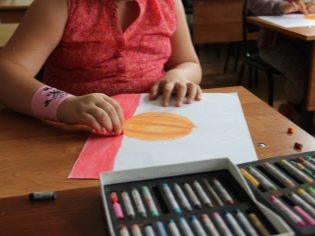Oil Pastels: Types and Values
Pastel is one of the traditional ways of drawing, which has won recognition even from those artists whose names are known throughout the world. Although it is generally accepted that this substance is designed specifically for professionals, in recent years, pastel crayons have been increasingly used for children's creativity in order to develop imagination and spatial thinking in children.
Naturally, such a drawing tool is somewhat different from all the usual pencils, so it is worth a closer look at what its key features are.
What it is?
With its long history and widespread prevalence, it should be noted that pastel is still a mystery to many parents. In fact, it looks approximately the same as ordinary children's crayons, that is, it is not dressed in any shell and can draw with absolutely all of its ends. A small exception is pastel pencils - these are, respectively, ordinary pencils, only with pastel crayons instead of slate pencil, but they are often referred to as unusual pencils than as unusual pastels.
Parents who purchase a drawing tool for their own children also care about the composition of what they buy. The main components of the oil pastel are, in fact, dyes, non-drying oil and wax. Oil bases are usually selected from natural origin, and if the dye is also added natural, then this chalk is completely safe for the child.
Pastels are rarely blamed for the negative impact on children's health, so we can safely say that this is one of the safest materials for children's creativity.
Advantages and disadvantages
Oil pastel has pros and cons compared not only with other materials for drawing, but also with other types of pastels. Its traditional benefits include the following, which will definitely be appreciated by the child:
- The ability to paint on virtually any surface, since a special composition successfully “clings” to a large amount of materials, including paper, wood, metal and glass surfaces, as well as fabric.
In this regard, parents should take a closer look at the organization of the creative process, otherwise the whole apartment will be described!
- Oil pastels resist drying, it is always fresh and soft enough not to require special efforts from the child for drawing. This chalk is also almost never crack, so it is very convenient to store for a long time.
- Unlike many other types of pastels, the oil version does not really need a fixer - because of its fat content, it is so well absorbed into the surface, which makes it possible not to process the surface of the pattern after the work is completed.
- The colors of oil pastels are very bright and pictorial, they resemble traditional oil painting, although they are made in a completely different technique. Even the inept first samples of the baby are very colorful and interesting, which only contributes to the further passion for drawing.
- Most types of pastels are completely safe for the child, which allows parents not to worry about the health of the baby.
There are no obvious flaws that would literally repel children from painting with oil pastels, so the following arguments would be interesting only to those children who have already reached a certain level of mastery in the visual arts and are looking for means with strictly defined properties. So, oil pastels can be criticized for the following features:
- Although the pattern itself, made by oil pastel, does not require any special fixation, it can be difficult to protect it with additional means (for example, from accidental ingress of moisture). Most fixers are not suitable for this purpose. This requires special substances, and another question is whether they will not spoil the creative idea.
- Oil pastel virtually eliminates the possibility of mixing the already existing colors in order to obtain new shades. It can not be done outside the surface of the picture because of the hardness of the material, and it is simply overlaid with a new color that is applied to paper or another substrate.
- Oil pastels are characterized by a fairly rigid edge, which is useful when depicting objects with clear outlines, but creates problems for drawing blurry outlines.
In general, oil pastels are very good material for children's creativity, but also at more serious stages of mastering the art of drawing, the application of it can be found at least as an additional element.
Kinds
Although oil pastels are in themselves a kind of pastels, with careful study, they can be classified according to certain characteristics. Due to the relatively small number of different parameters, all its varieties are relatively similar to each other, but still such differences are very noticeable to professional artists.
First of all, it should be noted that although all the pastel chalks from this category are made on the basis of oil, the amount of this ingredient in percentage may vary. In addition to the classic oil pastels, stands out also water-oil, as well as watercolor art oil pastels. The classic version gives the result as close as possible to oil painting and is considered more professional, although it requires fine work with a solvent.
Two alternative varieties have characteristic specificity, which makes it possible to wash them down with even ordinary water, which is very important for artists who for some reason do not tolerate caustic chemical odors.
In addition, any pastel, including oil, is divided according to the degree of hardness. Hard varieties are distinguished by increased dryness., in connection with which they cling to the surface somewhat worse, however only they can finely and accurately draw small details and contours, while the colors do not mix well. Soft pastel has completely opposite qualities - it adheres well to most of the basics and gives a few blurry outlines, mixing in the places of contact of multi-colored parts.
Due to this specificity, it is the soft species recommended for children.
Soft pastels can also be found individually, but more often multicolor sets are sold, which is especially convenient and practical in the case of children. Sets of 12 colors usually consist of one category of shades (standard, metallic luster or fluorescent), from 18-24 colors contain either an expanded palette of one category, or colors of two categories at once, but 36 and 50 colors are already a gift worthy even a pretty good artist.
How to choose?
When choosing oil pastels for a child, one should first of all take into account his needs, depending on the age and degree of mastery of the art of drawing. It is absolutely obvious that a teenager who already paints perfectly does not need the typical children's pastel, but something more professional, whereas for a beginner of preschool age the chalk skills are important even to a lesser extent,rather than safety and convenience.
In this regard, children usually buy soft crayons, which very easily leave a mark without any extra effort, and at the same time they paint on almost any surface, which does not require buying a special album for painting with pastels. Oil pastel drawing technique usually involves subsequent blurring after shadingHowever, the baby alone will not cope with such a difficult task, especially since the solvent used is probably toxic.
For this reason, newcomers are usually bought the oil pastels, which includes watercolor - it is beautifully washed away even with ordinary water.
Among other things, oil pastels can be used not only for classical drawing, but also for toning foamiran crafts. Experts say that dry pastels are better suited for this purpose, because it gives more juicy shades, but oil varieties cling to woven surfaces much better, although they require a longer drying time in well ventilated rooms.
To create foamiran handicrafts as a home hobby, oil pastel will be a very convenient addition.
Brands
In varieties of oil pastels, only experienced artists are well oriented, whereas for beginners who have never been interested in this topic before, it can be difficult to make a choice. For them, the easiest choice is targeting well-known brands, and sometimes this approach really works.
Most often on the shelves of domestic stores can be found oil pastels company "Ray". This brand is certainly known to all because of its widespread prevalence and an extensive range of a variety of products for children's creativity, as well as a very affordable price, but this is the trick: such tools are suitable only for fairly primitive arts.
In a word, by purchasing such crayons, you should not count on a special quality - this is, so to speak, the basic equipment
. If you really want to support the Russian manufacturer, it is better to pay attention to the oil pastel "Sonnet"produced by the company "Neva Palette".
If we compare products of foreign brands, then the goods of the Korean company are the most popular. Mungyo, which generally deals mainly with pastels, and in the world of oil crayons it has almost no equal. These are high-quality products of the optimum level of softness, allowing to draw even to a child, and yet designed even for the needs of serious artists. However, the range is wide enough to find the best options for each category of creative people.
As alternative brands of foreign oil pastels, the trademarks Derwent and Artbar deserve attention.
Optional accessories
If you buy only one oil pastel without any additional accessories, then there will be no more sense from it than from ordinary children's crayons. In order for the best qualities of the substance to appear with maximum efficiency, it is worth buying at least a special paper for painting with pastels - it has a corrugated texture, thanks to which the pigment clings better to its surface. In addition, this paper is thicker, which allows you to blur the strokes applied for an additional artistic effect.
However, soft children's varieties of pastels paint on any surface.
Again, water-based or pastel-colored baby oil pastels are washed away even with plain water, but thinner more serious professional varieties of this material will require a solvent. This substance should not be bought at random, and with an eye on the particular type of oil pastel used.
To clarify what type of solvent is needed, and you can buy what you want in any large store of goods for creativity.
Pastel, being an analogue of chalk, does not in itself require any additional devices for drawing, however, the solvent used for its dilution requires a special tool for application. Some artists put it on a shaded drawing with a special paper stick, others use ordinary brushes of a certain shape and size.
Reviews
It is even surprising why the use of pastels for children's creativity has such a short history, because the comments of parents on specialized forums make us think that this tool is very well suited for such purposes. It is not only safe, but also very convenient for kids, since the chalk draws from all sides and does not require any prior skills of holding in the hand, thanks to which even the smallest ones can draw.
Oil pastels, unlike other types of this substance, perfectly adhere to the canvases of different origin, and also almost always give very bright, saturated colors that children like a lot and stimulate their creative impulse. Moreover, pastel crayons leave a large space for creative growth, because over time, the child can master the technique of feathering, turning pastel drawings into an imitation of painting.
Finally, a huge range of products of this type allows each artist, regardless of age and preferences, to find the perfect tool for drawing.
For more information about the types and features of oil pastels, see the following video.
